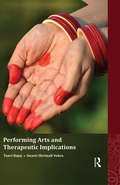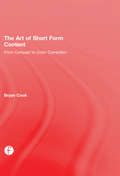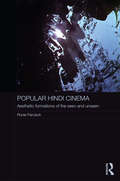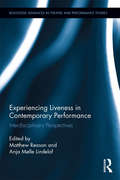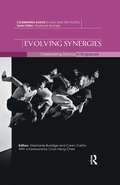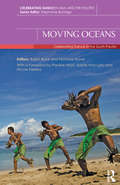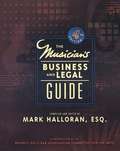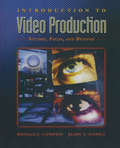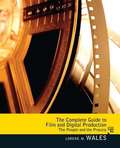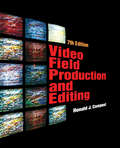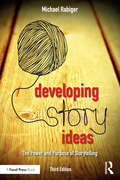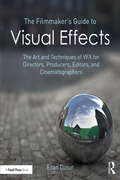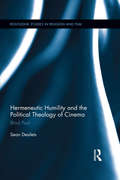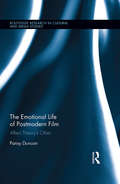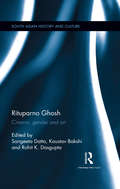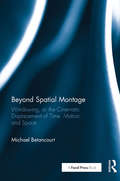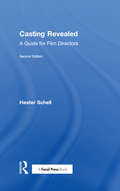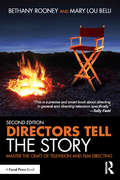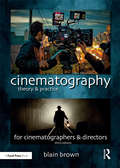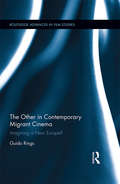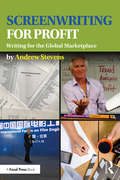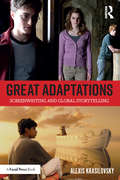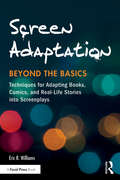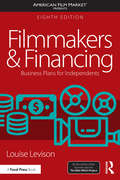- Table View
- List View
Performing Arts and Therapeutic Implications
by Tanvi Bajaj Swasti Shrimali VohraPresenting an alternative perspective, this book proposes that performing arts forge an emotional bond between the performer and the audience, making the act of performance a therapeutic and restorative experience, and not merely recreational. Studying the life-experiences of six artists, and their unique engagement with three art forms — music, drama and dance — the book highlights the physical, emotional, mental, and spiritual effects of performing arts both on the performers and the audience. More importantly, it takes the current understanding of the therapeutic role of arts beyond a deficit model of health that focuses on their use in curing illnesses, disabilities and imbalances, towards a more positive growth-centric model that relates them to promoting holistic mental health, well-being and happiness. It thus bridges the gap between the theoretical understanding of creative arts therapy and the practical experience of performing arts in non-therapeutic settings. Further, it assumes increasing relevance with respect to fast-changing lifestyles to which stress and ill-health are often attributed. The book will appeal to artists, educators and researchers of performing arts, applied psychology, counselling and therapy, and cultural studies, as well as interested general readers.
Essential Effects: Water, Fire, Wind, and More
by Mauro MaressaAnimate the world around you! Follow along with veteran Disney effects artist Mauro Maressa as he teaches you how to create and animate natural phenomena like water, fire, smoke, lightning, lava, mud, and wind. Essential Effects will help you plan, draw, design, and animate traditional 2D effects, taking your ideas all the way from rough sketch to finished product. Using a series of full-color visual breakdowns and diagrams, this book gives you a clear, concise understanding of what it takes to create credible, compelling effects in your own projects. Key Features Build a strong foundation of observation and drawing skills that you can rely on for the rest of your career Tips and tricks for applying classic effects principles to computer-animated and CG projects Over 400 full-color images and diagrams for clear step-by-step learning
The Art of Short Form Content: From Concept to Color Correction
by Bryan CookThe Art of Short Form Content: From Concept to Color Correction is an in-depth examination of the craft of creating short form filmic content – a category which includes television commercials, music videos, television promos, movie trailers, digital billboards, corporate videos, and pretty much anything else with a running time under five minutes. Though short form is an important part of the film industry, it is typically overlooked in books on the art of filmmaking. The Art of Short Form Content fills this industry void by answering the type of questions that working short form content creators deal with every day. As Cook explains, though short form content is limited in duration, it is not limited in quality and message. In this step-by-step, full-color guide you will find: • Interviews with leading short form content creators • Details on how to create everything from a corporate piece to a Super Bowl spot • Strategies for how to quickly attract viewer attention to your content • Extensive information on how to best utilize the craft of film-making in an advertising context • A comprehensive companion website that can be found at www.focalpress.com/cw/cook
Popular Hindi Cinema: Aesthetic Formations of the Seen and Unseen (Routledge Contemporary South Asia Series)
by Ronie ParciackThe popular Hindi film industry is the largest in India and the most conspicuous film industry in the non-Western world. This book analyses the pivotal visual and narrative conventions employed in popular Hindi films through the combined prism of film studies and classical Indian philosophy and ritualism. The book shows the films outside Western paradigms, as visual manifestations and outcomes of the evolution of classical Hindu notions and esthetic forms. These include notions associated with the Advaita-Vedānta philosophical school and early Buddhist thought, concepts and dynamism stemming from Hindu ritualism, rasa esthetic theories, as well as Brahmanic notions such as dharma (religion, law, order), and mokṣa (liberation). These are all highly abstract notions which the author defines as "the unseen": a cluster of diversified concepts denoting what subsists beyond the phenomenal, what prevails beyond the empirical world of saṁsāra and stands out of this world (alaukika), while simultaneously being embodied and transformed within visual filmic imagery, codes and semiotics that are teased out and analyzed. A culturally sensitive reading of popular Hindi films, the interpretations put forward are also applicable to the Western context. They enable a fuller understanding of religious phenomena outside the primary religious field, within the vernacular arenas of popular culture and mass communication. The book is of interest to scholars in the fields of Indology, modern Indian studies, film, media and cultural studies.
Experiencing Liveness in Contemporary Performance: Interdisciplinary Perspectives (Routledge Advances in Theatre & Performance Studies)
by Matthew Reason Anja Mølle LindelofThis volume brings together dynamic perspectives on the concept of liveness in the performing arts, engaging with the live through the particular analytical focus of audiences and experience. The status and significance of the live in performance has become contested: perceived as variously as a marker of ontological difference, a promotional slogan, or a mystical evocation of cultural value. Moving beyond debates about the relationship between the live and the mediated, this collection considers what we can know and say about liveness in terms of processes of experiencing and processes of making. Drawing together contributions from theatre, music, dance, and performance art, it takes an interdisciplinary approach in asking not what liveness is, but how it matters and to whom. The book invites readers to consider how liveness is produced through processes of audiencing - as spectators bring qualities of (a)liveness into being through the nature of their attention - and how it becomes materialized in acts of performance, acts of making, acts of archiving, and acts of remembering. Theoretical chapters and practice-based reflections explore liveness, eventness and nowness as key concepts in a range of topics such as affect, documentation, embodiment, fandom, and temporality, showing how the relationship between audience and event is rarely singular and more often malleable and multiple. With its focus on experiencing liveness, this collection will be of interest to disciplines including performance, audience and cultural studies, visual arts, cinema, and sound technologies.
Evolving Synergies: Celebrating Dance in Singapore (Celebrating Dance in Asia and the Pacific)
by Stephanie Burridge Caren CariñoA comprehensive overview of the dance culture of Singapore, this book embodies storytelling, personal reflections, memories, and histories of the artists. The extensive calendar of events encompassing companies and soloists from diverse dance practices, such as Indian, Malay and Chinese and a variety of Western contemporary dances, underline Singapore as a vibrant player in the evolution of Asian culture.
Moving Oceans: Celebrating Dance in the South Pacific (Celebrating Dance in Asia and the Pacific)
by Nicholas Rowe Ralph BuckCelebrating the diversity of dance across the South Pacific, this volume studies the various experiences, motivations and aims for dance, emerging from the voices of dance professionals in the islands. In particular, it focuses on the interplay of cultures and pathways of migration as people move across the region discovering new routes and connections.
The Musician's Business and Legal Guide
by Mark HalloranWritten specifically for musicians by legal and business experts in the music industry, this text covers nearly all of the confusing business and legal situations musicians find themselves in on the way to and through a professional career. It focuses on issues as they are actually practised with clause-by-clause commentaries on almost all the major music industry contracts.
Introduction to Video Production: Studio, Field, and Beyond
by Ronald Compesi Jaime GomezWritten in a clear, non-technical manner, Introduction to Video Production focuses on the fundamental principles of video production and the technologies used in production. This book discusses video aesthetics, technologies, and production practice in a clear and concise manner. It also emphasizes the importance of teamwork and planning in the production process. Chapters are clearly organized and heavily illustrated, with key terms identified in boldface. With Introduction to Video Production, readers will learn not only how the technology works, but how to work with the technology and with each other.
Complete Guide to Film and Digital Production: The People and The Process, CourseSmart eTextbook
by Lorene WalesNow available in an updated, 2nd edition, The Complete Guide to Film and Digital Production: The People and The Process, 2/e,discusses the entire production process for film and digital media, and provides you with a comprehensive view of production in the field, at live events, for mobile content and for animation. This book covers all aspects of the production process and readers learn the nuts and bolts of film and digital production from pre-production through delivery. This edition will make your production experience more marketable to an ever-expanding and converging industry.
Video Field Production and Editing
by Ronald CompesiVideo Field Production and Editing concentrates on video techniques and technology appropriate for "small scale" single-camera electronic field production (EFP) and electronic news gathering (ENG). This book offers the latest material on new digital field recording and editing technologies and is written in a concise, non-technical, user-friendly format. Reorganized and updated throughout, with new sections dedicated to HDV (High Definition Video) videotape recording formats, and tapeless digital recording media including high capacity optical discs, solid-state memory cards, and computer hard drives, the book walks the reader through the video production process from initial planning through final editing.
Developing Story Ideas: The Power and Purpose of Storytelling
by Michael RabigerThe vast majority of screenplay and writing books that focus on story development have little to say about the initial concept that inspired the piece. Developing Story Ideas: The Power and Purpose of Storytelling, Third Edition provides writers with ideational tools and resources to generate a wide variety of stories in a broad range of forms. Celebrated filmmaker and author Michael Rabiger demonstrates how to observe situations and themes in the writer's own life experience, and use these as the basis for original storytelling. This new edition has been updated with chapters on adaptation, improvisation, and cast collaboration's roles in story construction, as well as a companion website featuring further projects, class assignments, instructor resources, and more. Gain the practical tools and resources you need to spark your creativity and generate a wide variety of stories in a broad range of forms, including screenplays, documentaries, novels, short stories, and plays Through hands-on, step-by-step exercises and group and individual assignments, learn to use situations and themes from your own life experience, dreams, myth, and the news as the basis for character-driven storytelling; harness methods of screenplay format, dialogue, plot structure, and character development that will allow your stories to reach their fullest potential
The Filmmaker's Guide to Visual Effects: The Art and Techniques of VFX for Directors, Producers, Editors and Cinematographers
by Eran DinurThe Filmmaker’s Guide to Visual Effects offers a practical, detailed guide to visual effects for non-VFX specialists working in film and television. In contemporary filmmaking and television production, visual effects are used extensively in a wide variety of genres and formats to contribute to visual storytelling, help deal with production limitations, and reduce budget costs. Yet for many directors, producers, editors, and cinematographers, visual effects remain an often misunderstood aspect of media production. In this book, award-winning VFX supervisor and instructor Eran Dinur introduces readers to visual effects from the filmmaker’s perspective, providing a comprehensive guide to conceiving, designing, budgeting, planning, shooting, and reviewing VFX, from pre-production through post-production. The book will help readers: Learn what it takes for editors, cinematographers, directors, producers, gaffers, and other filmmakers to work more effectively with the visual effects team during pre-production, on the set and in post, use visual effects as a narrative aid, reduce production costs, and solve problems on location; Achieve a deeper understanding of 3D, 2D, and 2.5D workflows; the various VFX crafts from matchmove to compositing; essential concepts like photorealism, parallax, roto, and extraction; become familiar with the most common types of VFX, their role in filmmaking, and learn how to plan effectively for the cost and complexity of VFX shots; See visual effects concepts brought to life in practical, highly illustrated examples drawn from the real-world experiences of industry professionals, and discover how to better integrate visual effects into your own projects.
Hermeneutic Humility and the Political Theology of Cinema: Blind Paul (Routledge Studies in Religion and Film)
by Sean DesiletsThis book revisits the tradition of Western religious cinema in light of scholarship on St. Paul’s political theology. The book’s subtitle derives from the account in the Book of Acts that St. Paul was temporarily blinded in the wake of his conversion on the road to Damascus. In imitation of Paul, the films on which Sean Desilets’s analysis hinges (including those of Carl-Th. Dreyer, Robert Bresson, Pier Paolo Pasolini, and Carlos Reygadas) place a god-blind mechanism, the camera, between themselves and the divine. Desilets calls the posture they adopt "hermeneutic humility": hermeneutic in that it interprets the world, but humble in that it pays particular—even obsessive—attention to its own limits. Though these films may not consciously reflect Pauline theology, Desilets argues that they participate in a messianic-hermeneutic tradition that runs from Paul through St. Augustine, Blaise Pascal, Karl Barth, and Walter Benjamin, and which contributes significantly to contemporary discussions in poststructuralist literary theory, political theology, and religious studies. Desilets’s insightful explication of Jean-Luc Nancy’s deconstruction of Christianity and Georgio Agamben’s recent work on religion makes a substantial contribution to film philosophy and emerging critical trends in the study of religion and film. This book puts forward a nuanced theoretical framework that will be useful for film scholars, students of contemporary political theology, and scholars interested in the intersections of religion and media.
The Emotional Life of Postmodern Film: Affect Theory's Other (Routledge Research in Cultural and Media Studies)
by Pansy DuncanEmotion and Postmodernism: is it possible to imagine an odder couple, stranger bedfellows, less bad company? The Emotional Life of Postmodern Film brings this unlikely pair into sustained dialogue, arguing that the interdisciplinary body of scholarship currently emerging under the rubric of "affect theory" may be unexpectedly enriched by an encounter with the field that has become its critical other. Across a series of radical re-reappraisals of canonical postmodern texts, from Fredric Jameson's Postmodernism to David Cronenberg's Crash, Duncan shows that the same postmodern archive that has proven resistant to strongly subject-based and object-oriented emotions, like anger and sadness, proves all too congenial to a series of idiosyncratic, borderline emotions, from knowingness, fascination and bewilderment to boredom and euphoria. The analysis of these emotions, in turn, promises to shake up scholarly consensus on two key counts. On the one hand, it will restructure our sense of the place and role of emotion in a critical enterprise that has long cast it as the stodgy, subjective sister of a supposedly more critically interesting and politically productive affect. On the other, it will transform our perception of postmodernism as a now-historical aesthetic and theoretical moment, teaching us to acknowledge more explicitly and to name more clearly the emotional life that energizes it.
Rituparno Ghosh: Cinema, gender and art (South Asian History and Culture)
by Rohit K. Dasgupta Sangeeta Datta Kaustav BakshiAn iconic filmmaker and inheritor of the legendary Satyajit Ray’s legacy, Rituparno Ghosh was one of the finest auteurs to emerge out of contemporary Bengal. His films, though rooted firmly in middle-class values, desires and aspirations, are highly critical of hetero-patriarchal power structures. From the very outset, Ghosh displayed a strong feminist sensibility which later evolved into radical queer politics. This volume analyses his films, his craft, his stardom and his contribution to sexual identity politics. In this first scholarly study undertaken on Rituparno Ghosh, the essays discuss the cultural import of his work within the dynamics of a rapidly evolving film industry in Bengal and more largely the cinematic landscape of India. The anthology also contains a conversation section (interviews with the filmmaker and with industry cast and crew) drawing a critical and personal portrait of this remarkable filmmaker.
Beyond Spatial Montage: Windowing, or the Cinematic Displacement of Time, Motion, and Space
by Michael BetancourtBeyond Spatial Montage: Windowing, or the Cinematic Displacement of Time, Motion, and Space offers an extended discussion of the morphology and structure of compositing, graphic juxtapositions, and montage employed in motion pictures. Drawing from the history of avant-garde and commercial cinema, as well as studio-based research, here media artist and theorist Michael Betancourt critiques cinematic realism and spatial montage in motion pictures. This new taxonomic framework for conceptualizing linkages between media art and narrative cinema opens new areas of experimentation for today’s film editors, motion designers, and other media artists.
Casting Revealed: A Guide for Film Directors
by Hester SchellCasting is an essential component of any film or video project, but the core skill-set needed to cast effectively is little understood. Casting Revealed: A Guide for Film Directors is a straightforward manual on the art and craft of casting. Here, director Hester Schell offers her insider perspective on casting workflows, industry standards, finding actors, running auditions, what to look for in a performance, contracts, and making offers. This new edition has been updated with fresh interviews with casting directors, full color head shots, new information about online video submissions, and a companion website featuring forms, contracts, and sample scenes for auditions. Gain a fuller understanding of the misunderstood art and craft of casting actors for film and video production. Learn to find the right actors for any production, run auditions, interview actors, effectively judge performances and video submissions, evaluate suitability for a role, discover what it is you need from an actor, view headshots, draft contracts, make offers, and navigate current industry standards, unions, and procedures. This new edition has been updated to include full color sample head shots, new content on online video submissions, listings of casting wesbites, film resources, and film commissions and a companion website featuring interviews with celebrated casting directors from New York, Portland, Boston and Austin, necessary forms, sign-in sheets, contracts, and sample scenes for auditions.
Directors Tell the Story: Master the Craft of Television and Film Directing
by Bethany Rooney Mary Lou BelliMove over, movies: the freshest storytelling today is on television, where the multi-episodic format is used for rich character development and innovative story arcs. Directors Tell the Story, Second Edition?offers rare insight and advice straight from two A-list television directors whose credits include?NCIS,?NCIS New Orleans, Nashville, Criminal Minds and many more. Here, in one volume, learn everything you need to know to become an excellent director, not merely a good one. Covering everything through prep, shoot, and post, the authors offer practical instruction on how to craft a creative vision, translate a script into a visual story, establish and maintain the look and feel of a television show or film, lead the cast and crew, keep a complex operation running on time and on budget, and effectively oversee editing and post-production. Directors Tell the Story provides behind-the-scenes access to the secrets of successful directors, as well as exercises that use original scripted material. This newly updated edition features: All-new "From the Experts" sections with insider info known only to working professionals Profiles of top film and TV luminaries with advice and tips Additional „How I Got My First Job" stories from directors currently in the trenches Useful instruction to help you put directing techniques into practice A companion website featuring directing tutorials and video interviews with the authors Bethany Rooney has directed over two hundred episodes of prime-time network shows, including NCIS, The Originals, Nashville, NCIS New Orleans, and Criminal Minds. She teaches the Warner Brothers Directing Workshop and serves on numerous committees at the Directors Guild of America. Mary Lou Belli is a two-time Emmy Award winning producer, writer, and director as well as the author of two books. She directed NCIS New Orleans, Monk, Hart of Dixie, The Game, Girlfriends, and The Wizards of Waverly Place. She teaches directing at USC’s School of Cinematic Arts.
Cinematography: Image Making for Cinematographers and Directors
by Blain BrownThe world of cinematography has changed more in the last few years than it has since it has in 1929, when sound recording was introduced. New technology, new tools and new methods have revolutionized the art and craft of telling stories visually. While some aspects of visual language, lighting and color are eternal, shooting methods, workflow and cameras have changed radically. Even experienced film artists have a need to update and review new methods and equipment. These change affect not only the director of photography but also the director, the camera assistants, gaffers, and digital imaging technicians. Cinematography: Theory and Practice covers both the artistry and craftsmanship of cinematography and visual storytelling. Few art forms are as tied to their tools and technology as is cinematography. Take your mastery of these new tools, techniques, and roles to the next level with this cutting-edge roadmap from author and filmmaker Blain Brown. Whether you are a student of filmmaking, just breaking into the business, currently working in the industry and looking to move up to the next level, or an experienced professional who wants to update their knowledge of tools and techniques, this book provides both a basic introduction to these issues as well as more advanced and in-depth coverage of the subject. The companion website features additional material, including lighting demonstrations, basic methods of lighting, using diffusion and other topics. Topics Include: Visual language Visual storytelling Continuity and coverage Cameras and digital sensors Exposure techniques for film and video Color in-depth Understanding digital images Waveform monitors, vectorscopes, and test charts Using linear, gamma, and log encoded video Image control and grading on the set The tools and basics of film lighting ASC-CDL, ACES and other new methods Optics and focus Camera movement Set operations Green screen, high speed and other topics
The Other in Contemporary Migrant Cinema: Imagining a New Europe? (Routledge Advances in Film Studies #46)
by Guido RingsAs a rapidly aging continent, Europe increasingly depends on the successful integration of migrants. Unfortunately, contemporary political and media discourses observe and frequently also support the development of nationalist, eurosceptic and xenophobic reactions to immigration and growing multiethnicity. Confronting this trend, European cinema has developed and disseminated new transcultural and postcolonial alternatives that might help to improve integration and community cohesion in Europe, and this book investigates these alternatives in order to identify examples of good practices that can enhance European stability. While the cinematic spectrum is as wide and open as most notions of Europeanness, the films examined share a fundamental interest in the Other. In this qualitative film analysis approach, particular consideration is given to British, French, German, and Spanish productions, and a comparison of multiethnic conviviality in Chicano cinema.
Screenwriting for Profit: Writing for the Global Marketplace
by Andrew StevensThis book teaches readers how global trends define the marketplace for saleable screenplays in key international territories as well as the domestic market. Veteran writer, producer, and director Andrew Stevens gives you the insider edge you need to write for the global marketplace, sharing his decades of experience producing and financing everything from micro-budget independent films to major studio releases. In leveraging Stevens’ comprehensive experience, you will learn how to determine specific subject matter, genre, and story elements to make the most of international sales trends, and harness the power of these insider strategies to craft a screenplay that is poised to sell.
Great Adaptations: Strategies For Screenwriters In Today's World
by Alexis KrasilovskyGreat Adaptations: Screenwriting and Global Storytelling is the Second Place Winner in the 2019 International Writers Awards! A vast majority of Academy Award-winning Best Pictures, television movies of the week, and mini-series are adaptations, watched by millions of people globally. Great Adaptations: Screenwriting and Global Storytelling examines the technical methods of adapting novels, short stories, plays, life stories, magazine articles, blogs, comic books, graphic novels and videogames from one medium to another, focusing on the screenplay. Written in a clear and succinct style, perfect for intermediate and advanced screenwriting students, Great Adaptations explores topics essential to fully appreciating the creative, historical and sociological aspects of the adaptation process. It also provides up-to-date, practical advice on the legalities of acquiring rights and optioning and selling adaptations, and is inclusive of a diverse variety of perspectives that will inspire and challenge students and screenwriters alike. Please follow the link below to a short excerpt from an interview with Carole Dean about Great Adaptations: https://fromtheheartproductions.com/getting-creative-when-creating-great-adaptations/
Screen Adaptation: Techniques for Adapting Books, Comics and Real-Life Stories into Screenplays
by Eric R. WilliamsOnce you understand the basics of screenwriting, ideas for your next screenplay are everywhere. Whether it comes from a favorite children’s book, a summer novel you discover accidentally, a news story that catches your imagination, or a chapter from your own life — advanced screenwriting strategies should now guide you through your first adaptation. In Screen Adaptation: Beyond the Basics, award-winning screenwriter Eric Williams uses examples from award-winning screenplays to explain new storytelling techniques. His real-world examples illustrate a range of advanced approaches — including new ways to identify and craft tension, how to reimagine structure and character, and how to strengthen emotional depth in your characters and in the audience. Screen Adaptation: Beyond the Basics teaches readers new ways to engage with source material in order to make successful adaptation decisions, regardless of the source material. The book offers: Three detailed examples of award-winning adaptations by the author, including the complete short story and final scripts used in the Voices From the Heartland project; Breakout boxes highlighting modern and historical adaptations and providing examples for each concept discussed in the book; More than fifty charts providing easy-to-use visual representations of complex concepts; New screenwriting techniques developed by the author, including the Triangle of Knowledge, the Storyteller’s Parallax, and the idea of Super Genres as part of a Screenwriters Taxonomy.
Filmmakers and Financing: Business Plans for Independents (American Film Market Presents)
by Louise LevisonIn this new and updated ultimate filmmaker’s guide, Louise Levison gives you easy-to-use steps for writing an investor-winning business plan for a feature film, including: A comprehensive explanations for each of the eight sections of a plan Full financial section with text and tables A sample business plan A companion website with additional information for various chapters and detailed financial instructions ― advanced math not needed An explanation on how feature documentary, animated and large-format films differ A guide to pitching to investors: who they are, what they want and what to tell them Words of advice: Filmmakers share their experiences raising money from equity investors
